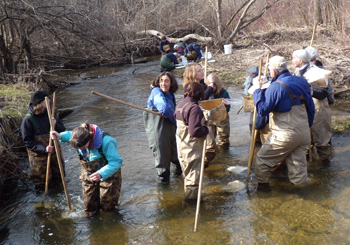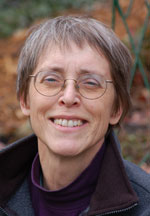Column: Seeds & Stems
Gardeners spend a lot of time working in their own world – moving the perennials, planning their walkways or weeding their vegetables.
But for some gardeners, the Michigan Conservation Stewards program has ushered in a larger world outside their backyard landscapes.
“My garden is something I do for me, but the stewardship program is what I do for others and for the larger environment,” says Mary Duff-Silverman, who went through the course last year.
The stewardship program introduces participants to the plants, animals and forces of nature that defy outsiders’ attempts to impose order. Instead, the steward-in-training has to understand the rules of that larger environment, with its invasive plants, water aeration, ground water and other natural processes.
This spring is only the second year the course has been offered in Washtenaw County. It’s a series of 11 classes that range over a number of ecological topics, including the ecosystems of wetlands, forests, lakes and streams.
This year’s program begins Saturday, April 10. If you’re interested, get more information online – you can also download the three-page application form from that website.
It will cost you $250 for the 11-week program, but some scholarships are available. Applications were due April 1, but late applications will be considered until the classes begin, said Robert Bricault, who is overseeing the stewardship program as part of his job as education coordinator at the Washtenaw County office of the Michigan State University Extension service. You can reach him at 734-997-1678.

Members from last year's Michigan Conservation Stewards class, on a field trip to Matthaei Botanical Gardens looking for bugs in Fleming Creek. (Photo courtesy of Bob Bricault.)
The program begins with an introductory session that runs from 9 a.m. to 4 p.m., but participants usually meet on Thursdays from 6 to 9 p.m. – with all-day field trips on Saturday, May 22 and Saturday, June 5.
The program requires that each student present a final project, something a bit disconcerting at first, said Duff-Silverman. Then, she thought of Dicken Woods, just four blocks from her house. Seven years ago, the 10-acre parcel was the center of a struggle between neighborhood residents and developers. In the end, the Ann Arbor City Council sided with neighbors who wanted to turn the neglected land into a park instead of a housing development or branch library.
Now you can walk through the area on a wood-chipped, figure-eight path. Some of the invasive buckthorn, honeysuckle and oriental bittersweet have been removed, and faded marker flags show where new trees – that look like twigs stuck in the ground – have been planted.
After talking to city parks staff last year, Duff-Silverman planted an entry garden of perennials near the entrance off Dicken Drive.
But that was just the beginning, as she became more involved with the site. Duff-Silverman now knows every foot of the nature area. She can point to the old well on the property, show where a house originally stood and explain why the vernal pond near Dicken Elementary School isn’t good for ducks (it dries up in the summer).
This year, she’s looking to establish plants like skunk cabbage in the wet, mucky areas, and she’s thinking about how the site could be used for educational projects.
“I was an armchair ecologist,” said Duff-Silverman. “The stewardship program got me out pulling on waders.”
As part of the stewardship course, participants attend talks by instructors from the University of Michigan, Michigan State University, state natural resources and conservation organizations – people with a wide experience you might not ordinarily encounter. On its field trips, the group sees the effects of prescribed burns or learns how to gauge the health of an ecosystem from the insects in a stream..
Some of the 18 members of that first class ended up counting frogs or working on signs or setting out trails. “It not about the extension service, because we don’t have a lot of volunteer efforts going on in conservation,” said Bricault. “But we have a lot of contacts with people who are doing conservation.”
The program even has an old hand like Bricault excited. Last year, he was helping with a tree count at Scio Woods Preserve on Scio Church Road, when he came across a wild growth of paw paws.
That tree inventory was part of a project done by two other members of the stewardship program: Judy Parsons and Dennis Purcell, who chose to do a survey of the preserve, which isn’t far from their home.
The couple have been out at the preserve this year, removing invasive species and planning for other improvements. “People see us working out here and thank us,” said Parsons.
The county parks department has done some improvements on the site, which was purchased only a year ago. Now there is a parking lot and an information kiosk near where a vacant house used to stand.
On one recent day, you still could see signs of the old homestead in a spray of snowdrops in a circle of an old garden bed. Over to one side was a pile of honeysuckle, hacked off by Parsons and Purcell, waiting for a county disposal crew. On the other side was a growing pile of wood chips, remnants of Norway maples on the property, waiting to be spread along the trail.
On a walk through the preserve last week, spring peepers and wood frogs were calling in the background. Trout lilies and spring beauties were poking through the dead oak and hickory leaves on the ground.
Purcell’s eye was quick to find the first green shoots of invasive garlic mustard, which he pulled out and put in his pocket for later disposal. He’s disgruntled at the invasive plants that have spread mostly at the edges of the property, but heartened by the cache of native blue flag iris in one of the boggy wetland areas.
And he’s thinking of improvements, such as placing benches in the woods, especially at a bluff overlooking what he and Parsons have dubbed Dead Turtle Pond.
Asked if he’s developed a sense of ownership over the property since he first took a look at it more than a year ago, Purcell brightens like a light bulb. “I guess I do,” he said, smiling.
After all their work, you’d think the two had finished with their part of the project, but Parsons takes a look at the area just behind the parking lot and surveys the invasive plants that have taken root in the area that was probably once someone’s backyard.
“We’ve still got about 10 years of honeysuckle removal to do,” she said.
About the writer: Marianne Rzepka, former reporter for the Ann Arbor News and Detroit Free Press, is a Master Gardener who lives in Ann Arbor and thinks it’s fun to turn the compost pile.







Tell me you didn’t title this “Stems and Seeds” for publication on the same day as Hash Bash on purpose! :-)
Seriously, though, it’s great to read about this sort of grass-roots stewardship.